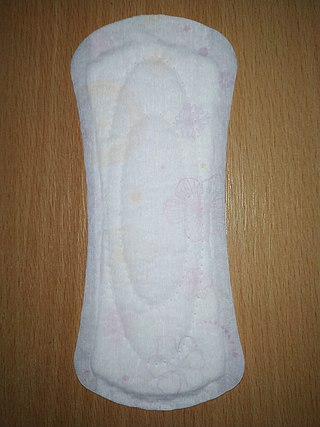Kotex
Brand of menstrual hygiene products From Wikipedia, the free encyclopedia
Kotex (/ˈkoʊtɛks/; KOH-teks) is an American brand of menstrual hygiene products, which includes the Kotex maxi, thin and ultra-thin pads, the Security tampons, and the Lightdays pantiliners. Most recently, the company has added U by Kotex to its menstrual hygiene product line.[1] Kotex is owned and managed by Kimberly-Clark, a consumer products corporation active in more than 80 countries.
 A Kotex "Deo" pad | |
| Product type | Menstrual hygiene products |
|---|---|
| Owner | Kimberly-Clark |
| Country | United States |
| Introduced | 1920 |
| Website | Kotex corporate website |


History
Summarize
Perspective
The modern, commercial, disposable pads started in the late nineteenth century with the Hartmann company in Germany, and Johnson & Johnson in the United States.[2] In the UK, the Birmingham firm of Southall Brothers & Barclay was advertising "sanitary towels" in The Family Doctor and Home Medical Adviser in the early 1890s.[3]
In the United States, Kotex was launched in 1920 by Kimberly-Clark to make use of leftover cellucotton (wood pulp fiber) from World War One bandages.[4][5] An employee noted that the pads had a "cotton-like texture" which was abbreviated to "cot-tex" and then made the product name with alternate spelling.[6]
In the 1920s, Kimberly-Clark placed advertisements in the women's magazines Good Housekeeping and Ladies' Home Journal.[7] Although some readers were offended by the ads, the product's success led to more advertisements. Kimberly-Clark also promoted Kotex in Good Housekeeping by using intimate advice columnist Mary Pauline Callender.[8]
Originally sold in a hospital blue box at 12 for 60 cents, Victorian sexual prudishness caused slow acceptance until Montgomery Ward began advertising them in its 1926 catalog, reaching $11 million sales in 1927 in 57 countries.[9] It became one of the first self-service items in American retailing history after it was strategically placed on countertops with a special payment box so that the woman didn't have to ask a clerk for it and touch hands. Tampax appeared in 1936. Belts were needed until the 1970 introduction of Stayfree by Personal Products Co. and New Freedom Pads by Kimberly-Clark.
New Freedom is a former brand in the Kotex family. New Freedom was one of the first beltless pads manufactured in the early 1970s.
Product line
In August 2009, Kotex launched a premium sub-brand called Kotex Luxe in Singapore. It launched U by Kotex Tween, products aimed at girls aged 8–12 in the US in 2011.[10]
Recalls and defects
In September 2012, Kimberly-Clark issued a warning regarding a shipment of rejected Kotex tampons stolen and sold to the public. The company said the defective products posed only a minor health risk to consumers.[11]
In December 2018, Kimberly-Clark issued a recall of U by Kotex Sleek tampons due to findings that the product would sometimes break apart during removal, leaving behind fragments in the body that could require medical attention for removal.[12]
Notes
References
Further reading
External links
Wikiwand - on
Seamless Wikipedia browsing. On steroids.
